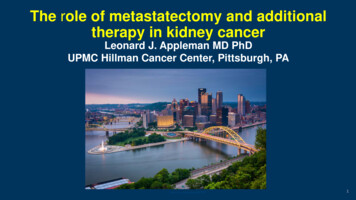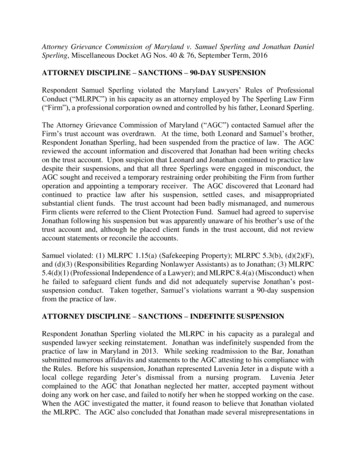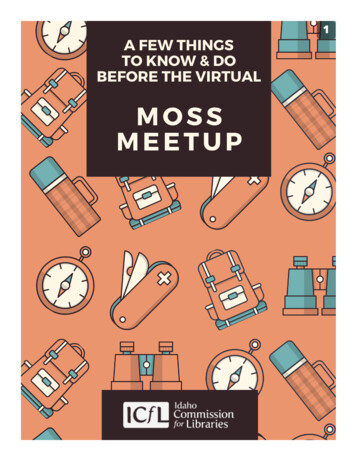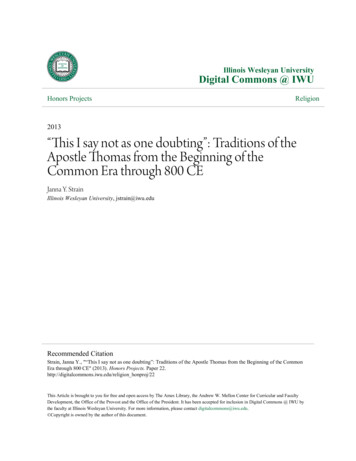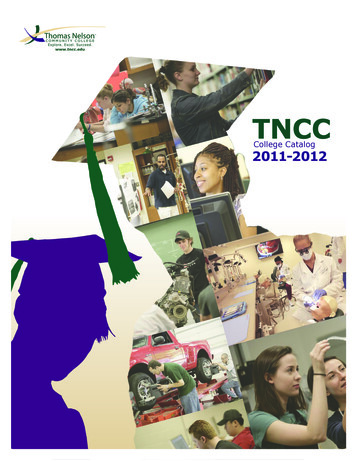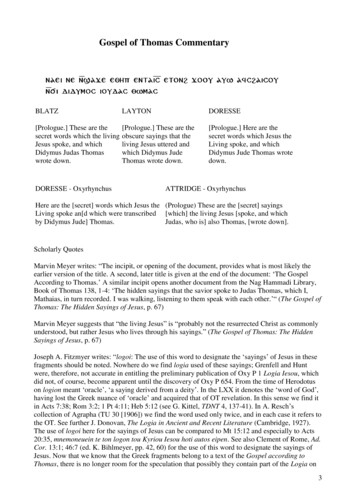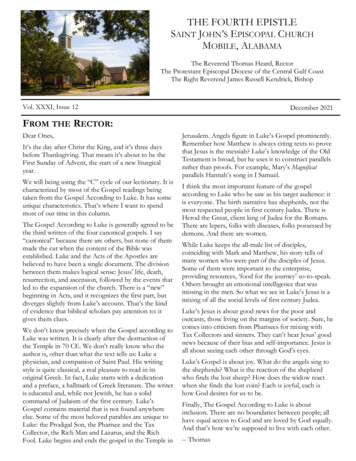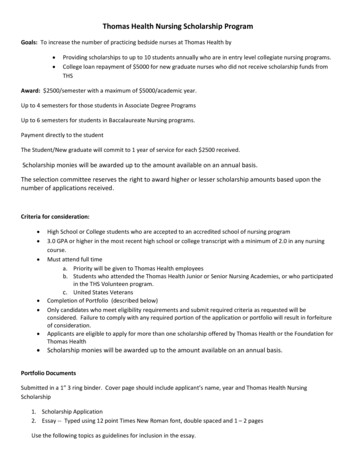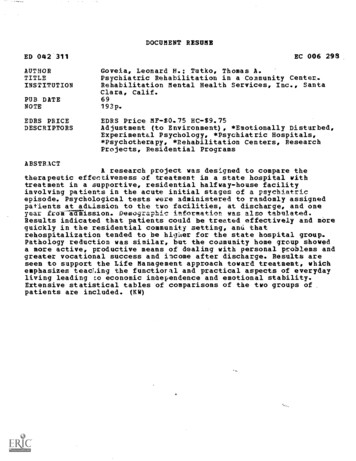
Transcription
DOCUMENT RESUMEEC 006 298ED 042 311AUTHORTITLEINSTITUTIONGoveia, Leonard H.; Tutko, Thomas A.Psychiatric Rehabilitation in a Community Center.Rehabilitation Mental Health Services, Inc., SantaClara, Calif.PUB DATE69193p.NOTEEDRS PRICEDESCRIPTORSEDRS Price MF- 0.75 HC- 9.75Adjustment (to Environment), *Emotionally Disturbed,Experimental Psychology, *Psychiatric Hospitals,*Psychotherapy, *Rehabilitation Centers, ResearchProjects, Residential ProgramsABSTRACTA research project was designed to compare thetherapeutic effentiveness of treatment in a state hospital withtreatment in a supportive, residential halfway-house facilityinvolving patients in the acute initial stages of a psychiatricepisode. Psychological tests were administered to randomly assignedpatients at adLission to the two facilities, at discharge, and oneyear frolrrdrnisSion. Demographic information was also tabulated.Results indicated that patients could be treated effectively and morequickly in the residential community setting, and thatrehospitalization tended to be higiier for the state hospital group.Pathology reduction was similar, but the community home group showeda more active, productive means of dealing with personal problems andgreater vocational success and income after discharge. Results areseen to support the Life Management approach toward treatment, whichemphasizes teac%ing the functioral and practical aspects of everydayliving leading co economic independence and emotional stability.Extensive statistical tables of comparisons of the two groups ofpatients are included. (KW)
qr-41OOLLIPSYCHIATRIC REHABILITATION IN A COMMUNITY CENTERbyLeonard H. Goveia, M.A.andThomas A. Tutko, Ph.D.U.S. DEPARTMENT Of HEALTH, EDUCATION t WELFAREOFFICE OF EDUCATIONTHIS DOCUMENT HAS BEEN REPRODUCED EXACTLY AS RECEIVED FROM THEPERSON OR ORGAM/ATION ORIGINATING IT. POINTS OF VIEW OR OPINIONSSTATED DO NOT NECESSARILY REPRESENT OFFICIAL OFFICE OF EDUCATIONPOSITION OR POLICY.Rehabilitation Mental Health Services, Inc.846 Jackson StreetSanta Clara, California 95050
TABLE OF CONTENTSPAGPrefaceivList of FiguresList of TablesI.REHABILITATION MENTAL HEALTHSERVICES, INC.A.B.C.II.B.C.D.E.F.B.C.D.E.F.23Why a Community Care HomeIdeologyPhysical DescriptionStaffServices and imsSubjectsExperimental DesignInvestigations and HypothesesResultsC.Individual InvestigationsOverview of Total USSIONA.V.1RESEARCHA.IV.Organization HistoryCurrent ProgramsFuture ProgramsCOMMUNITY CARE ndix A176Appendix B179Appendix C184
PREFACEThis research project resulted from experience gainedthrough many years of providing community-oriented treatmentand rehabilitation programs utilizing the vehicle of thehalfway-house concept.Our experience in these years raised aseries of questions regarding an innovative use of a residentialhalfway-house facility; this use being specifically for patientsin the acute initial stages of a psychiatric episode.Theultimate focus of these questions was simply whether or not ahalfway-house could be used effectively as an alternative tohospitaltzation for some patients whose only recourse fortreatment was hospitalization.The study as described herein was devised as an experimentalmethod of gathering and evaluating information relating to thecomparative effectiveness of residential treatment and rehabilitation and that of institutional treatment for patients whoseillness traditionally has required hospitalization.A research project as extensive and comprehensive as thisone, in order to achieve its objectives, requires the cooperation and participation of countless community agencies andcitizens.To express our appreciation to all would be anunending task.However, there is a need for personal expressionsof gratitude to some for outstanding contributions.The participation and support of Agnews State Hospital wasenthusiastic and of great value to the project.The hospital'sMedical Director and Superintendent, Walter Rapaport, M.D.,opened the resources of the hospital to us at the onset of the
research project in 1964.Emmett Litteral, M.D., RussellGould, M.D., and Redin Baker, M.D. were of particular assistanceas were other hospital staff members.The participation of the Adult and Child Guidance Clinicin providing psychiatric services when needed was another majorcontribution, as were the contributions of the State Divisionof Vocational Rehabilitation, Department of Welfare of SantaClara County and San Jose Community Mental Health Services.Statistical consultation provided by Robert Clarke, Ph.D., andMr. Richard Neville's many hours of statistical-analysis workplayed major roles in dealing effectively with the vast amountof data collected.A debt of gratitude is owed to the National Institute ofMental Health (NIMH) for the financial grant which made theproject possible and for its understanding and interest whichled to a one year extension of the grant.The NIMH Regionaloffice in San Francisco, particularly Mr. Ray Craig, providedthe necessary support and consultation which was most encouraginand helpful to the program.Thomas A. Tutko, Ph.D., Co-investigator; Glen Robertson,CC% Supervisor; George McCarthy, Psychological Test Examiner;and Marge Zeller, RMHS Office Manager, should be commended forthe many hours of work above and beyond expectation which theydedicated to the project.Without their technical skills andperseverance, our research objectives would not have been aseffectively achieved.ii
The development of the various treatment and rehabilitationunits of the agency historically has been dependent on thejudgment and courage of the agency's Board of Directors.research project was no exception.ThisIt was made possible throughthe insight and direction of these men and women, all of whomhave a real concern for people and the fortitude to act on ti.eirconcern.For their crucial role in opening horizons for moreeffective psychiatric treatment, a sincere expression ofgratitude is made.L. H. G.iii
LIST OF FIGURESPAGE NO.FIGURE NO.492603704805906.103I71358139iv
LIST OF TABLESTABLE NO.PAGE 925952698v
TABLE NO.PAGE 8394041424344454647484950515253, 54:55.116. . -117119.120OOOO122123124125127128. .129131. .132133. . . 136. 140. . .143.,s.145147150153
I.REHABILITATION MENTAL. HEALTH SERVICES, INC.A.Rehabilitation Mental Health Services, Inc. (RMHS) wasone of the early forces in the contemporary halfway -housemovement in the United States.The agency was organizedin 1953 by civic and business leaders with the assistanceof members of the professional staff of Agnews StateHospital.In 1953 the agency became involved in meetingthe needs of psychiatric patients who, upon discharge fromthe hospital, found themselves in a precarious situation dueto limited funds, unemployment, poor housing and the absence of healthy family ties.The agency worked withpatients primarily to find suitable housing in hotels,rooming houses, etc.It made available financial loansto patients when needed and provided opportunities foremployment placement.To assist with employment placementthe organization established an Employment Committee com-posed of representatives of business, industry and laborand other individuals with employment contacts.Thefunction of this committee was to interview each patientwith the purpose of assessing his vocational skills, toengage in vocational, counseling regarding the developmentof interview techniques and resume composition, and tomake the .necessary contacts within their own ).,ndustry orother industries to secure employment placement for thepatient.The services of the agency were provided through community Volunteer participation and resulted in widespreadand scattered resideUtial placement of patients in the
San Jose-Santa Clara area.As the program developed interms of larger caseloads, follow-up services, etc., itbecame apparent that a professional staff was needed andthat the agency should move in the direction of establishing treatment and rehabilitation housing units to furtherincrease the effectiveness of its work.In 1956 the firsthalfway -house of the agency, the Quarters for Men, wasopened in the city of Santa Clara (current populationapproximately 90,000), located 50 miles south ofSan Francisco.Currently the agency is a non-profit tax - exemptcorporation governed by a twenty-one-member Board ofDirectors composed of civic leaders of the San Jose -Santa Clara community.The organization's historycharacterizes it as a pace-setter in community mental-health action through the continued development of itsresidential treatment and rehabilitation facilities andprograms for psychiattieB.patients.Current ProciumsQUARTERS FOR MEN,This halfway -house facility wasopened in 1956 with the assistance of a three-year federal.research grant from the Office ofVocational Rehabilitation(now known as the Vocational Rehabilitation Administration).The facility is located in a residential section of thecity of Santa Clara and has accommodations for seven menAnd one live-in staff person.Its primary purpose is towork with patients leaving psychiatric hospitals- -providingtreatment, rehabilitation and socialization services to- 2
assist these patients in their transition from hospitalto community living.QUARTERS FOR WOMENThis facility, opened in 1961,is a two-story home in the adjacent city of San Jose(current population 425,000) with accommodations for ninewomen and one live-in staff person.The services, ob-jectives and population of this facility are similar tothose of the Quarters for'Men.COMMUNITY CARE HOMEThis facility--the subjectof this report -- opened in 1964 with the assistance of afour year research grant from the National Institute ofMental Health.Primarily it is used as an alternative tonospitalization for acutely ill patients.The purpose,services and population will be discussed in greaterdetail in succeeding pages of this report.ADOLESCENT RESIDENTIAL CENTERThis unit includesa two-story home and a single-story home located next toeach other in a residential section of the city ofSanta Clara.The primary purpose of the program is towork with adolescent boys and young male adults from theages of 16 to 21 who are experiencing emotional andadjustment problems at home, in school, and/or in thecommunity.The facility accommodates 13 residents, onelive-in housemother and two live-in college students.C.Future ProgramsRESIDENCE-WORKSHOPThe agency .1.s currently inthe final stages of opening in the community a residentialfacility in conjunclon with a workshop for severely- 3 -
chronic and marginal individuals with long-term historiesof psychiatric illness.The plan is to locate suitablehousing to accommodate approximately 15 residents and aworkshop with a potential of including up to 50 clients.The basic function of this service is to develop maximumlevels of functioning for chronic patients in theemotional, social and vocational areas.
II.COMMUNITY CARE HOMEA.Why a Community Care Home?After working with residents of the Quarters for Menand the Quarters for Women for many years, it becameapparent that many of the barriers which obstructedpatients from achieving successful treatment and rehabilitation were related to their hospitalization.Thesebarriers were not particularly inherent to the illnessbut resulted from being removed from the community.Thedevelopment of these problems for the most part wasunavoidable; nevertheless, for most patients the resultantimpediment to rehabilitation was severe and for someinsurmountable.Reference is made to the strong depend-ency needs which many patients develop after prolongedperiods of hospitalization - -needs which associate anycircumstance resembling iiidependent living with fear andpanic, interfering with the achievement of rehabilitationgoals.Secondly, reference is also made to social resist-ance, reflected through community apathy, misunderstandingand negative attitudes.The stigma of having been hos-pitalized in a psychiatric hospital continues as atroublesome reality.Thirdly, the niche the patient leftin the community upon being hospitalized is often notthere when he returns as family members and friends closeranks.Lastly, re-employment problems are frequentlysevere, as employers are often reluctant to re-hire aformer employee and skeptical of a new applicant who is onrecord as having'been -hospitalized in a state institution.
In short, if the illness is not of itself overwhelmingenough, paying the social and other consequences of havingbeen hospitalized is.With these observations in mind, the concept of aCommunity Care Home (CCH) was developed.The CCH wouldbe a halfway-house functioning at the other end of thespectrum.The facility would accept referrals from thecommunity who were demonstrating acute symptoms of anillness and needed to be removed from their stressfulenvironment.It would be used as an alternative tohospitalization whenever appropriate, providing psychiatrictreatment in conjunction with rehabilitation services.It would therapeutically affect the possibility for thepatient to achieve recovery without being removed fromhis community and avoid the residual problems which toofrequently arise from being hospitalized in a large institution.Further, it would offer an economy of bothtime and finances to the patient and to his community.B.IdeologyAnyone involved in offering direct services in themental-health field is soon exposed to the various puzzlingaspects of the mental illness phenomenon.He finds theillness complex, reminding him of how little he actuallyknows and how much his treatment techniques are based ontheory, often without substantiating empirical fact.But, in spite of this and the known and unknown neurological and psychological factors in human behavioral problems,one factor consistently shows itself.- 6 -Emotional
disturbances, thinking, attitudes, feeling, etc., areinfluenced by psychological and social elements ofenvironment.As long as people must cope daily with theirenvironment and adjust to other people, emotional tranquility will remain a slippery goal and will often beadversely affected by environmental conditions resultingin disturbances of various sorts and degrees expressedthrough behavioral symptoms.These behavioral symptoms can repeatedly be tracedto failures in the socialization process as it relatesto establishing meaningful, satisfying relationships withpeople and developing what might be termed effective"life management".The frequency of these symptoms in the diagnosedillness leads to the speculation that they may be notonly symptoms--but possibly tne illness itself.It wouldappear that7-if the illness reflects psychological andsocial problems--then, whenever possible, the individualshould be treated within the social structure from whichstemmed his difficulty.The ideal treatment setting would seem to be onewhich would offer services directly associated with environmental adjustments without a drastic change ofenvironment.It would be a treatment center in thecommunity which would make available to the patient thenecessary medical (psychiatric and non-psychiatric) andrehabilitation services while offering him the kind ofhuman interest, concern, acceptance, warmth and
understanding that would be consistent with promotingimproved adjustment to society.It would also be a centerat which focus would be placed on daily learning experiencesto assist the patient in managing his life more effectivelyin social, vocational, and emotional areas and to avoidcreating the kinds of crisis which originally precipitatedhis illness.CCH was designed to be such a halfway-housetreatment facility.C.Physical DescriptionThe Community Care Home is a two-story home inSan Jose, California.The facility is located approxi-mately one mile from the downtown area in an establishedresidential district.It is convenient to bus lines,shopping areas and city resources.Itlis-6-Ii-eWhomewith the capacity to house comfortably ten male and femaleresidents.There is a full basement available for varioususes and an adequate laundry area with appropriate equipment.The back yard is large, with adequate parking anda barbeque pit.The home is attractively furnished, withconventional and functional decor and a warm, homelikeatmosphere.D.StaffLeonard H. Goveia, M.A.Executive Director, RMHSPrincipal Investigator ofCCH research projectThomas A. Tutko, Ph.D.Co-Investigator, CCHresearch projectEmmett B. Litteral, M.D.Psychiatric ConsultantGlen D. Robertson, M.A.psychologist,CCH Supervisor
E.George McCarthyPsychological Test ExaminerMarjorie B. ZellerOffice ManagerSylvia LoveHousemotherServices and Community AffiliationsThe CCH staff established working ties with numerousresources in the community.From these ties developed awide range of services available to CCH residents.Contactwith medical and psychiatric hospitals and clinics, privatepractitioners, the State Division of Vocational Rehabilitation, Goodwill Industries, State Employment Service, privateemployment agencies, industrial and business concerns, laborunions, the Santa Clara County Welfare Department, SantaClara County Mental Health Services and other agencies weremajor sources of assistance in the development of theseservices.The total services available to each residentas a result of these community resources in combination withthe services provided by CCH staff included:Medical edication supervisionspecial ication supervisionconsultationPsychologicalindividual therapygroup therapypsychological testingand interpretationfamily counselingmarriage rkshop experiencepractice interviews inindustrial settingemployment placementFinancial Aidgrants or loans asneededHousingsupportive group livingincluding 3 meals aday
Social and llow -upon a formal orinformal basisIn addition to the above-mentioned services, provisionwas made for full-time around-the-clock crisis coverage.A professional staff member was available at all times forresidents and ex-residents alike whose circumstancesrequired immediate attention.F.PoliciesCommunity Care Home policies were originally established by the residents and since then have been revised,structured and developed by the House Council.Policiesare seen as guidelines and have been subject to continuedre-evaluation by residents in consultation with staff.Most recent policies assign residents to various responsibilities in connection with the upkeep of their rooms,the home, kitchen facilities and yard.Residents areexpected to observe the house curfew unless other arrangements are made with the staff.The use of alcohol in thehouse is prohibited and could jeopardize the continuedresidency of '.he client.Residents do their own ironingand share with the Housemother in the cooking responsibilities.Residents are encouraged to be up for breakfast,out of their rooms during the day, involving themselvesin community-oriented activities.Residents are expectedto assume the responsibility of fee payment up to theirability to do so.Policies are kept flextble end at a
a minimum and are generally pointed to having residentsaccept levels of responsibility corresponding to andencouraging their recovery and rehabilitation.
III. RESEARCHA.BackgroundA number of Changes involving therapy have been witnessed in the last several decades.Rather than an in-dividual approach, the present emphasis is on groupinteraction whether in group therapy, milieu therapy orcommunity therapy.The latter of these has become acommonly accepted part of many institutions.The thera-peutic community as outlined by Jones (1953; 1958; 1961;1968) reports success in handling large groups of patientsas does Rademaeker (1948) in describing the Gheel Shrine.A most notable development in community mental-healthtreatment has been the halfway- house.This treatmentusually follows discharge of a patient from a hospitalfacility into a residential group living installation inthe community.The halfway house approach represents anoted departure from traditional institutional treatment,allowing patients to continue treatment and rehabilitationwhile living in housing very closely resembling their ownhomes.Such an approach continues the treatment morerealistically by preparing the patient for community life.A number of such institutions have grown over thepast decade.Richmond (1969) points out that such treat-ment often prepares some patients for independent livingwhile for others it prepares them for living closely ina semi-independent setting.The functions and the typeof homes have varied, but each seems to fill the growingneed for treatment in a small, homelike social milieu.
Several articles ha:re attempted to describe the nature ofthe halfway house (Huseth, 1961; Sharp, 1964; Richmond,1969).The increasing numbers of sch homes indicate achanging philosophy toward treatment - -that which centersaround the home and the community.In some instances attempts have been made to go onestep beyond this tyr of treatment.An example of thisis the cooperative apartment house where patients shareindividual apartments (Hodgman and Stein, 1966).Thischange represents a further departure from traditionaltreatment and one that may possibly be more in line withindependent and realistic living in terms of the patient'sown life.This changing treatment emphasis opens a number ofavenues for community therapy.In fact, the role of thecommunity as a therapeutic agent has become increasinglyemphasized with the advantage of such an approach includingthe opportunity for the patient to maintain contacts withhis job and family, and to avoid the stigma of being a"mental patient".The Quarters, as previously described, has providedthis type of link since 1956 for the patient with thecommunity (Goveia, 1965).From observations of theQuarters programs now in progress it is known that theQuarters serves as a therapeutic "family" unit within thecommunity.It can be an aid in helping patients to rehab-ilitate themselves in a shorter period of time than mightbe the case at a larger State institution.- 13 -Other attempts
have been successful using a similar although not exactapproach.(Evans, Bullars and Solomon, 1961; Greenblatt,Levinson and Klerman, 1961; Meyer and Borgotta, 1959;Steinman and Hunt 1961).Whereas the Quarters has been used as a residentialtreatment facility for post-hospital patients, the Com-munity Care Home as described in this paper is a similarhalfway-house used in lieu of hospitalizations for patientsin the acute phases of psychiatric illness.It is the intent. of this research program to demon-strate that the CCH program is a more effective method oftreatment than is hospitalization in a large institution,and provides a greater economy to the patient and thecommunity.B.Alms1.GeneralThe general aim of this research project is tocompare the therapeutic effectiveness of treatment in aState hospital, Agnew State Hospital (ASH), with treatmentat Community Care Home (CCH).CCH provides treatment andrehabilitation services to patients living in a supportive,residential, co-educational home.The aim is to demon.'strate objectively what value might accrue to the patientsfrom the two treatment facilities and how effective eachis over a period of four years.2.SpecificThere are a number of specific aims within theproject.Seven separate aspects of the program wereassessed over the four year period.U -
The first investigation was to determine whethera halfway-house can effectively treat patients in theacute stages of their illness and be used in lieu ofhospitalization.The second investigation attempted to determinewhich of the two treatment facilities was more effectivein reducing re-hospitalization and to compare the lengthof treatment for each group.The third investigation was to determine whetherCCH treatment significantly reduced pathology as comparedwith ASH treatment.Moreover, it was an attempt to deter-mine changes in pathology over a period of time.The fourth investigation was to determine whetherthe employability, following treatment, of CCH patients wasgreater than ASH patients.Also, an attempt was made tocompare post-treatment income as related to Loth treatmentsettings.The fifth investigation was an attempt to determine the relationship between treatment setting and thepatient's attitude toward treatment, the installation,and mental illness.The sixth investigation foCused on the effect ofthe two types of treatment upon the patient's attitudestoward self, others, and the community.The seventh investigation involved comparingsuccessfully and unsuccessfully treated patients at CCHto determine those variables which differentiated thetwo groups.- 15 -
C.SubjectsThe subjects included in the research project consisted of 98 patients.were females.group.Of these, 60 were males and 38There were 62 patients included in the CCHOf these, 38 were males and 24 were females.TheASH group consisted of 36 patients of which 22 were malesand 14 were females.Diagnostic and demographic informa-tion regarding subjects may be found in Appendices A andB respectively.D.Experimental Design1.ProcedureThe design of this project was to select fromcommunity sources patients whose hospitalization wasimminent.Through the process of randomization patients'placement (CCHor ASH) was determined.Patients were primarily accepted from theadmission wards at ASH with the exception of those listedin Appendix C.Professional staffs at local community hospitalsand clinics were informed of the project.The admittingdoctors at these installations notified CCH when patientswere admitted who appeared to be eligible for the project.The psychologist from CCH gave the patient an extensiveinterview and determined the patient's eligibility andwillingness to participate in the research project.eligibility of the patient was based on the followingcriteria:- 16 -The
Ineligible patients were excluded whose problemswere anic impairmente.Homocidal or suicidal tendencies withvery high risk.Eligible patients were included:a.who had at least minimal realitycontact with some accessibilityto treatment and rehabilitationb.whose need for hospitalization wasmedically determinedc.whose symptomology stemmed fromreaction to stressful environmentalfactors.If, after the interview, the patient was considered to be eligible, the interviewing psychologistinformed the patient about the project.If the patientagreed to participate, the psychologist called the CCHsecretary in charge of random numbers.She, in turn, wouldinform the psychologist of the disposition of the patientbased on the randomization process.There were separatelists of random numbers for males and females and onlythe secretary and Research Director had any contact withthe list.Upon assigning a number to an eligible patient,it would be crossed off and the next number used for thefollowing referral.Following determination of patient's disposition,the psychologist would inform the patient whether he was- 17 -
to be hospitalized or admitted to CCH.In either case,he was told that he would be contacted by another psychologist to be given a battery of psychological tests.The disposition of the patient was then discussedwith the referring ward doctor who initiated the necessarysteps to hospitalize the patient or to discharge him toCCH.If a referral originated from the community, anappointment was made to interview the patient.If thepatient was eligible, he was informed about the projectand the random selection.If he agreed to participate,disposition was determined and he was immediately admittedto ASH or CCH.2.Group II PatientsMidway through the research project it wasrecommended by visiting consultants from the San FranciscoRegional Office of National Institute of Mental Healththat a second experimental group be introduced.Thischange was made in order that CCH could be used to maximmum capacity.If a patient in the special group (Group II)passed the screening criteria, he was accepted into CCHwithout disposition being determined by random numbers.Because there was a possibility of differences in levelsof manifest pathological behavior, comparisons were madebetween patients in this special group and those patientswhose disposition was determined by the randomizationprocess.Comparisons were made on the MMPI, MMPI DerivedScales and demographic data.In the event no significantdifferences occurred, this special group would be collapsed- 18-
with those patients at CCH whose placement was determinedrandomly.These comparisons are discussed in Section III,F (Results).3.MaterialsEach patient was given a battery of five.testsincluding the Wechsler Adult Intelligence Scale (WAIS), theMinnesota Multiphasic Personality Inventory (MMPI), theRorschach, the Semantic Differential, and the Draw AFamily Test (DAFT).These tests, except for the WAIS, were repeateda second time upon leaving the installation and a thirdtime one year from the date of entrance into the project.Thus it became possible to make comparison on three different occasions:upon entrance into treatment, uponcompletion of treatment, and a year following entrance intothe project.The WAIS was given primarily as a control measureto determine if both groups were intellectually equivalent.Except for the Semantic Differential, the remaining testswere given to determine the level of pathology as reflectedby objective scores.In using the MMPI, t scores wereused for the 13 original
DOCUMENT RESUME ED 042 311 EC 006 298 AUTHOR Goveia, Leonard H.; Tutko, Thomas A. TITLE Psychiatric Rehabilitation in a Community Center. INSTITUTION Rehabilitation Mental Health Services, Inc., Santa. Clara, Calif. PUB DATE. 69. NOTE. 193p. EDRS PRICE EDRS Price MF- 0.75 HC- 9.75. DESCRIPTORS. Adjustment (to Environment), *Emotionally Disturbed,
